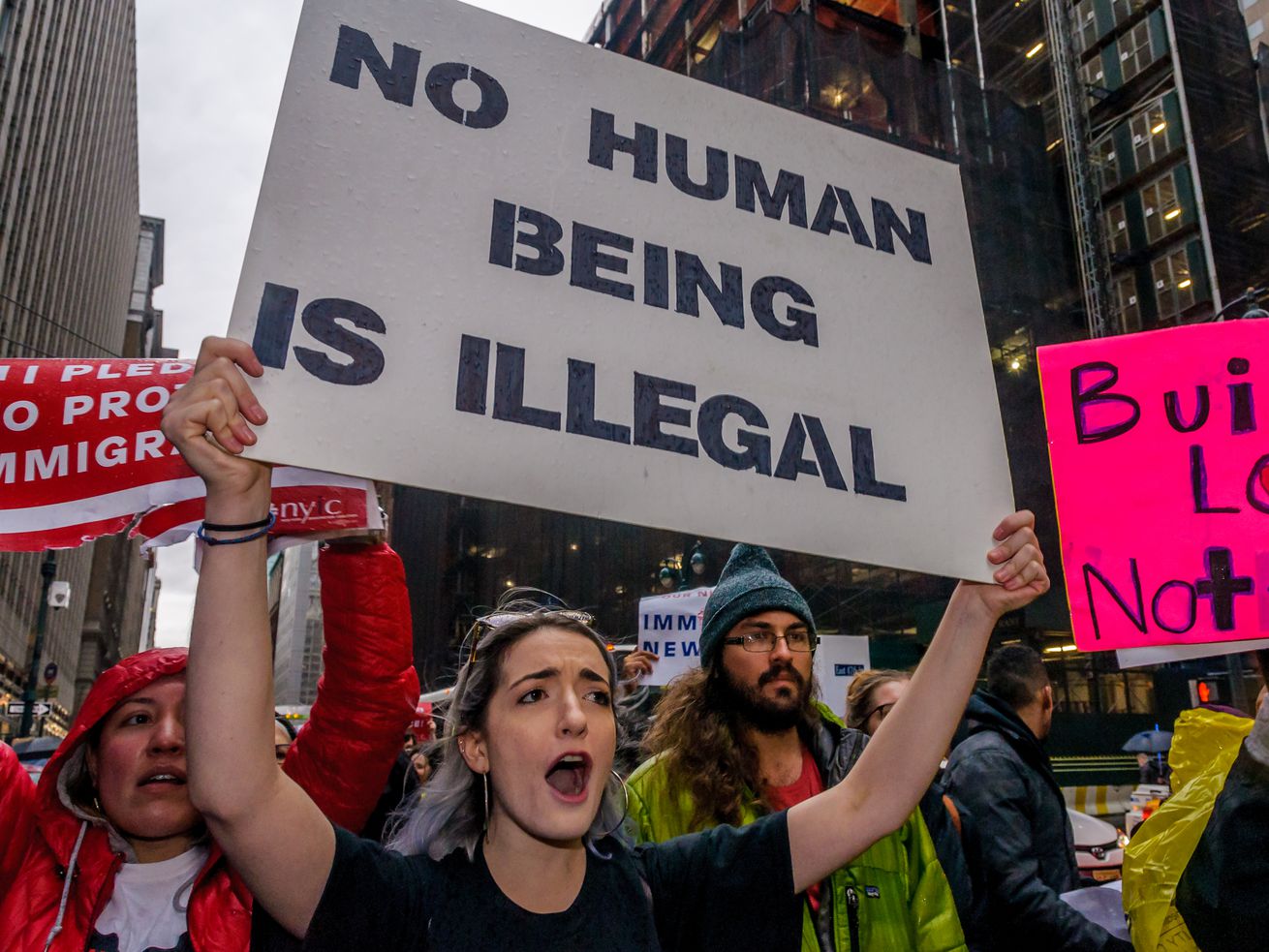Congress legalized millions of undocumented immigrants in 1986 — and it could again.
Among President Joe Biden’s key campaign promises on immigration was to create an eight-year path to citizenship for the more than 11 million undocumented immigrants living in the US as part of a broader reform package that is currently stalled in Congress.
Republicans have decried the proposal as a magnet for further unauthorized immigration, but GOP lawmakers supported a similarly sweeping law to legalize the undocumented population in 1986 — the last and only legislation of its kind that Congress has passed.
Nearly four decades later, it’s clear the Republican position isn’t completely correct. Legislation like the 1986 law, known as the Immigration Reform and Control Act (IRCA), could actually reduce unauthorized immigration and give the US economy a boost as it continues to recover from the pandemic.
The IRCA was one of Ronald Reagan’s key bipartisan achievements at a time when the Senate was also closely divided, with Republicans having a slim majority. And it can offer a benchmark for Democrats pursuing legalization efforts today.
The bill, which passed 63-24 in the Senate, granted green cards to nearly 2.7 million people — roughly three-quarters of the undocumented population at the time — who had been in the country continuously for at least four years, who paid a fine and back taxes, and who demonstrated what was defined as “good moral character.” It also introduced penalties for employers who hire undocumented immigrants and increased border enforcement.
In the years after its implementation, it mitigated unauthorized immigration and improved socioeconomic mobility for the immigrants who were legalized and their families, leading to a new surge of Latino political power. But it still didn’t resolve the challenge of unauthorized immigration for good, given that the undocumented population in the US has more than quadrupled in the intervening years.
Though some have argued that a similar bill could never pass in today’s partisan environment — particularly following former President Donald Trump’s efforts to stir up anti-immigrant sentiment — IRCA’s prospects seemed similarly bleak. It was the result of more than 15 years of negotiations, with the anti-immigrant and pro-immigrant camps in Congress drawing strict battle lines. And it was declared “dead” several times before it ultimately passed, earning it a reputation as the “corpse that would not die.”
That should serve as a lesson to today’s lawmakers, who could be doing more to exhaust the option of bipartisan legislation rather than staking their hopes on managing to keep their caucus unified enough to pass a bill through budget reconciliation without any Republican votes, said Charles Kamasaki, a senior cabinet adviser at the immigrant advocacy group UnidosUS who wrote a book about IRCA.
“These kinds of bills are really hard to pass. Before they pass, they almost invariably die,” he said. “You have to be in a constant search for where you can get the votes. And that inevitably involves trade offs and compromises that aren’t necessarily fully satisfactory to either side.”
Partisanship has risen sharply since the mid-1980s, but some immigration experts believe that it’s still worth it for Democrats to pursue serious bipartisan negotiations on immigration — if not to actually identify room for compromise and achieve an agreement, then to convince their caucus that budget reconciliation is the only way forward. Failing to act will leave millions continuing to live in the shadows as kind of permanent underclass, vulnerable to exploitation and to removal from a country where many of them have laid roots.
Legalization limited unauthorized immigration levels
Anti-immigration hawks often make the argument that enacting another mass legalization program would only set a precedent encouraging more immigrants to cross the border without authorization in the hopes that they, too, might one day achieve legal status. Sen. Thom Tillis, for example, wrote in an April Fox News op-ed that Biden’s proposal for “mass amnesty” would send a “clear signal that our border is open for anyone and everyone.”
But several studies have found either no significant change, or a modest decline, in unauthorized immigration levels on the US-Mexico border due to IRCA in the years immediately following the law’s implementation. And a 2011 paper by Joshua Linder, then at American University’s School of Public Affairs, found that there were fewer apprehensions of migrants at the southern border over the long-term period from 1986 to 2000 than there would have been without IRCA. Even though the overall number of unauthorized immigrants living in the US has grown significantly in decades since IRCA, it could have been even larger.
“[A]mnesty programs do not encourage illegal immigration, contrary to the vigorous claims of some critics of amnesty programs,” Linder writes.
He acknowledges that there might be other reasons not to endorse another mass legalization push, such as potential costs and effects on the US economy. But setting a bad precedent for future migrants isn’t one of them.
Rather, what might have actually contributed to the rise in the unauthorized immigrant population was the rapid expansion of immigration enforcement in the years following 1986, which actually caused more migrants to decide to settle in the US permanently, Princeton sociologist Doug Massey and his co-authors found in a 2016 paper.
Before the IRCA, Mexican people had moved back and forth across the border, usually looking for opportunities for temporary work and crossing in El Paso and San Diego. The US’s decision to expand immigration enforcement didn’t really alter their ability to cross the border. They weren’t much more likely to be apprehended when they attempted to cross, and even if they were discovered by US immigration officials and swiftly returned to Mexico, they could still succeed after multiple attempts.
What changed, however, was the costs and risks associated with returning to their home country and then attempting to reenter the US because of greater penalties for being apprehended. Migrants had to start crossing in more dangerous regions of the border, going through the Sonoran Desert and Arizona, and came to rely more heavily on the services of paid smugglers, which became more expensive. Between 1980 and 2010, the probability that a migrant would return to their home countries after their first trip to the US consequently dropped from 48 percent to zero, according to Massey’s paper.
What might reverse the trend, the paper argues, is if the US legalizes the population of undocumented immigrants living in the US, or at least broad swaths of it, which might allow more people to return to their home country. They wouldn’t need to pay smugglers in order to eventually come back to the US should they desire, and they wouldn’t face adverse immigration consequences if they were caught trying to cross the border without authorization.
Newly legalized immigrants and their communities reaped the benefits
The benefits of the 1986 mass legalization are even clearer several decades later — and not just for the immigrants who were granted legal status.
Affected immigrants’ wages grew by as much as 15 percent within five years of the bill’s implementation and 20 percent in the long-run while their poverty rates declined. That’s likely because they were accepting low wages in order to mitigate the risk of deportation and were vulnerable to exploitation by employers, but legalization removed barriers to seeking better paying jobs and also incentivized immigrants to improve their educational attainment and English skills in order to earn even more. Those higher wages mean more tax revenue and more consumer purchasing power.
They became more likely to be naturalized citizens — with about a third of those legalized becoming citizens by 2001 — and less likely to work in occupations that traditionally hire many unauthorized immigrants. One 20-year study also showed that they laid down more permanent roots and contributed more to their communities as a result of legalization, opening bank accounts, buying homes and starting businesses.
It’s reasonable to expect that their children also fared better as a result, especially given that the children of undocumented immigrants are more likely to be poor and have worse health outcomes than children of people with legal status.
Research suggests that national crime rates also declined by a persistent 3 to 5 percent, or about 120,000 to 180,000 fewer violent and property crimes annually, due to IRCA’s implementation.
“It was a boon for not just those families, but for the their communities as well,” said Muzaffar Chishti, a senior fellow at the Migration Policy Institute, a pro-immigration think tank, who previously lobbied for the bill and was involved in its implementation.
The economic payoffs of mass legalization could be even greater today given the demographic challenges that the US is currently facing, Chishti said.
There is a widening gap in the number of working-age adults that are able to support an aging population of baby boomers, as evidenced by 2020 Census figures that showed the lowest population growth the US has seen since the 1930s. This puts the US both in danger of worker shortages in key industries like home health care, hospitality, transportation, and construction, but also of long-term population declines of the sort Japan and Italy are currently grappling with.
Immigration has historically insulated the US from population decline and represents a kind of tap that the US can turn on and off. Over the next decade, it is set to become the primary driver of population growth for the first time in US history. Legalization could help make it a more effective tool.
Legalization should be tied to reforms to the legal immigration system
IRCA’s biggest fault is that it focused exclusively on unauthorized immigration and ignored reforms expanding the legal immigration system, and any attempt to replicate its successes would need to improve upon that legal system.
The US has issued roughly about 1 million green cards annually for most of the 21st century, though those numbers dipped under Trump. Only about 14 percent of those green cards are reserved for people coming to the US for work and their family members. Increasing the current caps on green cards for employment-based immigrants across the skills spectrum would help address labor market need in the US while also creating new legal pathways for people to come to the US rather than trying to cross the border without authorization or pursue an asylum claim.
“The vast majority of immigrants coming to the U.S.-Mexico border clearly want the opportunity to enter a legal process, and many of them are accessing the only legal process available to them: asylum and related procedures,” David Bier, a policy analyst at the right-leaning Cato Institute, writes.
The amount by which employment-based immigration should be increased is debated. The Migration Policy Institute has suggested tying it to the number of new unauthorized immigrants who come to the US annually: about 250,000. That number could potentially shift over time as the US’s demand for labor changes.
“If we just increase employment-based immigration by 250,000 a year, we’ll be getting close to letting letting supply meet demand,” Chishti said.
Others have advocated for increases to all forms of legal immigration across the board, not just for those coming to the US to work.
Chishti said that legalization and increases in legal immigration should also be accompanied by a more robust employment eligibility verification system, such as some form of universal, mandatory E-Verify, which is currently optional for most employers. That’s especially important given that the sanctions in IRCA for employers who hired undocumented immigrants didn’t end up having much teeth. Some have cautioned that expanding E-Verify on its own would end up hurting small businesses and their workers — but those negative effects might be mitigated if they have access to a new pool of legalized workers.
Still, Chishti questioned the feasibility of pairing new legal paths for immigrants, an employment based increase, and tougher employment eligibility in a comprehensive reform package, a format that has failed time and time again in Congress over the past two decades.
“The combination of these three things would get us to a better place,” he said. “Unfortunately it doesn’t work politically.”
Getting to 60 votes in the Senate on legalization is a tall order today
The current conventional wisdom on the left is that, unlike in 1986, bipartisanship on immigration is dead — that there is no point in seeking compromise with Republicans, and that reconciliation, which allows Democrats to pass policy on their own, is the only way to push through the Democratic agenda. The struggle to reach a deal on Biden’s bipartisan infrastructure package, and the uncertainty over whether the agreement will pass the Senate, suggests that we shouldn’t expect anything different on immigration — particularly given infrastructure improvements are something most lawmakers of both parties are for, whereas the same can’t be said for immigration reform.
“It took a popular president like Reagan to make [IRCA] happen,” Chishti said. “Reagan is the last president we had who not only could tell his own party what to do, but he could also tell a significant number of Democrats what to do.”
But Kamasaki said that the level of bipartisanship over immigration in the Reagan era was “pretty heavily overrated” and that the restrictionist position was generally more dominant. What’s more, polling shows that immigration was much less popular amid the public in those days.
“While the pro- and anti-immigrant factions in both parties, those lines were pretty clear and they were pretty rigid and frankly, not terribly different from where they are now,” Kamasaki said.
What ultimately drew more progressive Democrats to the bill who had initially been hesitant was a provision to extend temporary protections to citizens of countries suffering from natural disasters or armed conflict, he said. That provision was eventually stricken from the bill before its passage, but it helped get more people invested in it. There might be similar bargaining chips that exist today.
“I think there may well be similar kinds of measures that that might be attractive to moderate Democrats and Republicans now,” Kamasaki said. “But it’s going to be hard to unearth those without having substantive discussions.”
While passing an immigration reform bill via reconciliation may be ideal for Democrats, it’s also critical that they thoroughly explore bipartisan options, Kamasaki said. There are weaknesses to the reconciliation route: there are limitations on what can be included in a reconciliation bill, and it would be vulnerable to individual senators opting not to cooperate. Seeing the prospect of a bipartisan deal exhausted might also help more Democrats get on board with reconciliation to reach the necessary 50-vote threshold in the Senate.
And Republicans concerned about immigration should keep in mind that Democrats might be willing concede certain enforcement measures, even though they aren’t talking about it right now. In 2017, for example, some were willing to trade permanent legal protection for more than 700,000 young undocumented immigrants who came to the US as children for $25 billion in border wall funding. Expanding E-Verify might also be a potential concession, Kamasaki said.
“My critique of the field these days, really on both sides, is that there aren’t a lot of people working at it,” he said. “Unless you actually talk to people and figure out what their limits are, it’s hard to even potentially craft compromise.”
Author: Nicole Narea
Read More



